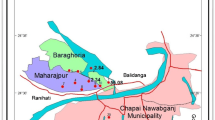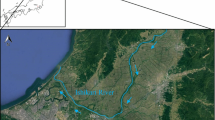Abstract
Sediments from shallow aquifers in Bengal Delta, India have been found to contain arsenic. Rivers of Ganga-Brahmaputra system, responsible for depositing these sediments in the delta, have created a store of arsenic. Geomorphological domains with different depositional styles regulate the pattern of distribution of zones with widely different content of groundwater arsenic. The high arsenic zones occur as narrow sinuous strips confined to channel deposits. A few iron-bearing clastic minerals and two post-depositional secondary products are arsenic carriers. Secondary siderite concretions have grown on the surface of the clastic carriers in variable intensity. The quantity of arsenic in all clastic carriers is in excess of what is generally expected. Excess arsenic is contributed by the element adsorbed on the concretion grown on the surface of the carriers, which adds up to the arsenic in the structure of the minerals. Variable abundance of concretions is responsible for the variable quantity of arsenic in the carriers and the sediment samples. Fe2+ for the growth of siderite concretions is obtained from the iron-bearing clastic carriers. The reaction involves reduction of trivalent iron to bivalent and the required electron is obtained by transformation of As3+ to As5+. It is suggested that oxidation of As3+ to As5+ is microbially mediated. In the Safe zone arsenic is retained in the carriers and groundwater arsenic is maintained below 0.05 mg/l. In the Unsafe zone sorbed arsenic is released from the carriers in the water through desorption and dissolution of concretion, thereby elevating the groundwater arsenic level to above 0.05 mg/l.








Similar content being viewed by others
References
Acharyya SK (1997) Arsenic in ground water: geological overview. Consultation on arsenic in drinking water, World Health Organization, New Delhi, May, 1997
Appelo CAJ, Van der Weiden MJJ, Tournassat C and Charlet L (2002) Surface complexation of ferrous iron and carbonate on ferrihydrite and the mobilization of arsenic. Env Sci Technol 36:3096–3103
Arnold RG, DeChristina TJ, Hofman MR (1988) Reductive dissolution of Fe(III) oxides by Pseudomonas sp. 200. Biotechnol Bioeng 32:1081–1096
Baur WH, Onishi BMH (1969) Arsenic. In: Wedepohl KH (ed) Handbook of geochemistry. Springer, Berlin Heidelberg New York
Bhattacharyya P, Chatterjee D, Jacks G (1997) Occurrence of arsenic-contaminated groundwater in alluvial aquifers from delta plains, Eastern India: options for safe drinking water supply. Water Resour Dev 13:79–92
Boyle RW, Jonasson IR (1973) The geochemistry of As and its use as an indicator element in geochemical prospecting. J Geochem Explor 2:251–296
CGWB (1999) High incidence of arsenic in groundwater in West Bengal. Central Ground Water Board, India, Ministry of Water Resources, Government of India
Davis JA, Kent DB (1990) Surface complexation modeling in aqueous geochemistry. Rev Mineral 23:177–260
Dong H, Fredrickson JK, Kennedy DW, Zachara JM, Kukadapu RK, Onstott TC (2000) Mineral transformation associated with the microbial reduction of magnetite. Chem Geol 169:299–318
Dowling CB, Poreda RJ, Basu AR, Peters SL (2002) Geochemical study of arsenic release mechanisms in the Bengal Basin groundwater. Water Resour Res 38(9):1173
Goldberg S, Glaubig RA (1988) Anion sorption on a calcareous montmorilonitic soil-arsenic. Soil Sci Soc Am J 52:1297–1300
Kinniburgh DG, Smedley PL (2001) Arsenic contamination of groundwater in Bangladesh. Technical Report WC/00/19; Brit Geol Surv, Keyworth UK, vol 1–4
Kostka JE, Nealson KH (1995) Dissolution and reduction of magnetite by bacteria. Environ Sci Technol 29:2535–2540
Little B, Wagner P, Ray R, Hart K, Lavoie D, Nealson K, Aguilar C (1997) The role of biomineralisation in microbiologically influenced corrosion. Biodegradation 9:1–10
Lovley DR, Chapelle FH (1995) Deep subsurface microbial process. Rev Geophys 33:365–381
Lovley DR, Coates JD, Blunt-Harris EL, Philips EJP, Woodward JC (1996) Humic substances as electron acceptors for microbial respiration. Nature 382:445–448
Mallick S, Rajagopal NR (1996) Groundwater development in the arsenic affected alluvial belt of West Bengal: some questions. Curr Sci 70:956–958
Mandal BK, Chowdhury TR, Samanta G, Basu GK, Chowdhury PP, Chanda CR, Lodh D, Karan NK, Dhara RK, Tamili DK, Das D, Saha KC, Chakraborty D (1996) Arsenic in groundwater in seven districts of West Bengal, India: the biggest arsenic calamity in the world. Curr Sci 70:976–986
Manning BA, Goldberg S (1996) Modeling competitive adsorption of arsenate with phosphate and molybdate on oxide minerals. Soil Sci Soc Am J 60:121–131
McArthur JM, Ravenscroft P, Safiulla S, Thirlwall MF (2001) Arsenic in groundwater: testing pollution mechanisms for sedimentary aquifers in Bangladesh. Water Resour Res 37:109–117
Millero F, Huang F, Zhu XR, Liu XW, Zhang JZ (2001) Adsorption and desorption of phosphate on calcite and aragonite in sea water. Aquat Geochem 7:33–56
Mukherjee PK, Pal T, Sengupta S, Shome S (2001) The Arsenic-rich phases in aquifer sediments from southern West Bengal, India. J Geol Soc India 58:173–176
Nickson R, McArthur J, Burgess W, Ahmed K M, Ravenscroft P, Rahman M (1998) Arsenic poisoning of Bangladesh groundwater. Nature 395:338
Nickson RT, McArthur JM, Ravenscroft P, Burgess WG, Ahmed KM (2000) Mechanism of arsenic release to groundwater, Bangladesh and West Bengal. Appl Geochem 15:403–413
Oremland RS, Stolz JF (2003) The ecology of arsenic. Science 300:939–944
PHED (1991) Arsenic pollution in groundwater in West Bengal. Report of Arsenic Investigation Project to the National Drinking Water Mission, Delhi, India
Pichler T, Veizer J, Hall GEM (1999) Natural input of arsenic into a coral reef ecosystem by hydrothermal fluids and its removal by Fe (III) oxyhydroxides. Environ Sci Technol 33:1373–1378
Pye K, Dickson JAD, Schiavon N, Coleman ML and Cox M (1990) Formation of siderite-Mg-calcite-iron sulphide concretions in intertidal marsh and sandflat sediments, north Norfolk, England. Sedimentology 37:325–343
Sengupta S, Mukherjee PK, Bhattacharya D (2003) Pattern of distribution of arsenic contaminated groundwater in the delta region of West Bengal and its causes. In: International Conference on the Role of Natural Resources and Environment in Sustainable Development in South and Southeast Asia (NESDA). Abstr vol, p 62
Sinha Ray SP (1997) Arsenic in ground water in West Bengal. Consultation on arsenic in drinking water, World Health Organization, New Delhi, May, 1997
Smedley PL, Kinniburgh DG (2002) A review of the source, behaviour and distribution of arsenic in natural waters. Appl Geochem 17:517–568
Acknowledgements
The authors are grateful to the Director General, Geological Survey of India for permission to publish this paper. We thank Dr Prosun Bhattacharya of Department of Land and Water Resources, Stockholm for reviewing the paper and suggesting improvements.
Author information
Authors and Affiliations
Corresponding author
Rights and permissions
About this article
Cite this article
Sengupta, S., Mukherjee, P.K., Pal, T. et al. Nature and origin of arsenic carriers in shallow aquifer sediments of Bengal Delta, India. Env Geol 45, 1071–1081 (2004). https://doi.org/10.1007/s00254-004-0965-8
Received:
Accepted:
Published:
Issue Date:
DOI: https://doi.org/10.1007/s00254-004-0965-8




